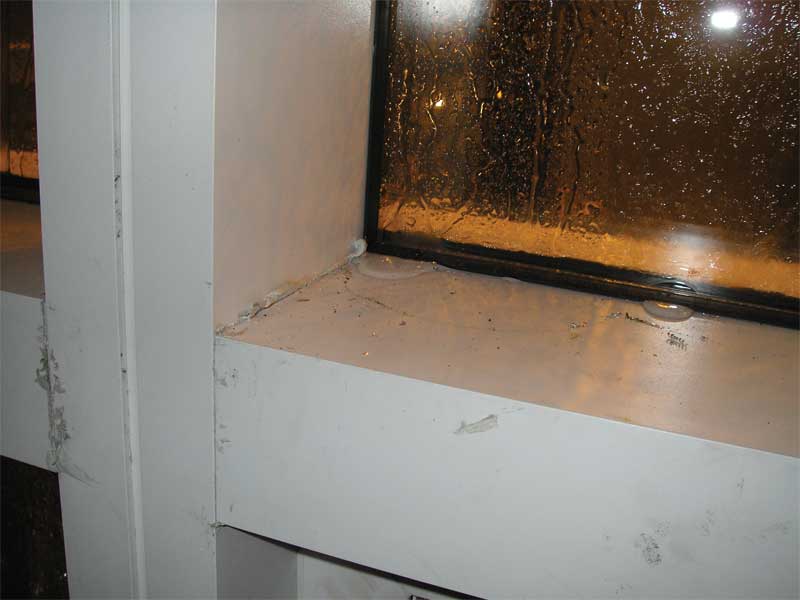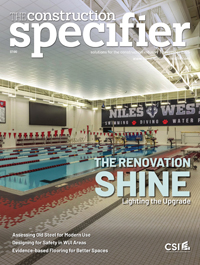Referencing and specifying fenestration field-testing
Outcomes
The outcome of the quality control testing is either pass or fail: if the measured air infiltration rate is less than the specified threshold, the product passes. For water-penetration-resistance testing, specifications often require that testing produce no uncontrolled leakage at the given test pressure. However, the outcome of testing is often subject to debate because ‘leakage’ is poorly defined.
Pass/fail criteria and a leakage definition must be clear in the specifications to limit the potential for situations requiring further interpretation. Specifiers have freedom to define pass/fail criteria to meet their expectations, while design professionals use multiple definitions for water leakage.
AAMA 502 defines water leakage as:
the penetration of uncontrolled water beyond a plane parallel to the innermost edges of the product and that indisputably originates from the fenestration product.
AAMA 503, on the other hand, defines it as:
water that is not contained in an area with provisions to drain to the exterior or the collection of more than 0.5 oz. [14 g] of water during the 15 min. test period on top of an interior horizontal framing member surface. Any water present shall not extend beyond a plane parallel to the glazing intersecting the innermost projection of the test specimen, not including interior trim and hardware, under the specified conditions of air pressure difference across the specimen.

Figure 5 shows the test.
AAMA 501.2 defines water leakage as:
any uncontrolled water that appears on any normally exposed interior surfaces, this is not contained or drained back to the exterior, or that can cause damage to adjacent materials or finishes. Water contained within drained flashing, gutters, and sills is not considered water leakage. The collection of up to 0.5 oz [14 g] of water in a five-minute test period on top of an interior stop of stool integral with the system shall not be considered water leakage.
AAMA 502 allows for collection of water on horizontal surfaces of the window assembly as long as the water does not flow over the edge of the surface onto interior finishes, whereas AAMA 503 and 501.2 limit the amount of water that collects on horizontal surfaces to 14 g (0.5 oz). Despite these definitions, end-users and owners may object to water that collects on interior surfaces of the fenestration product. The project team should discuss the ‘leakage’ definition during the drafting of the specifications to ensure the included definition meets the project team’s expectations.
Consequences of failure
Should a failure occur, AAMA 502 and 503 require forensic testing methods to follow AAMA 511, which references ASTM E2128. AAMA 502.1 requires the contractor implement a repair that is acceptable to the architect and/or owner’s representative and retest the location to ensure the repair
is effective. If the remedial repair is not effective, the contractor must provide repairs and retest until the test results are satisfactory.
AAMA 502 and 503 do not provide guidance as to what is required once the point of leakage is determined. Commonly, the contractor may propose a repair (either local or systemic depending on the nature of the failure), and retest the fenestration after repair to verify its efficacy.
For each unsuccessful test, there should also be an additional test on another similar fenestration specimen to check whether the failure is applicable to multiple fenestrations on the project or only an isolated defect. Stipulating this progressive means of testing after failure increases the likelihood of identifying a systemic issue if it exists.
Conclusion
Quality control testing programs help owners validate installed fenestration assemblies before accepting the installation of an approved product on the building. A testing program can range in size and scope, but AAMA establishes minimum guidelines. Prudent owners and architects can use these guidelines to set forth testing requirements through project specifications, and then implement testing to understand the submitted and installed product’s performance relative to expectations.
Validating the initial installation is critical. It can alert the project team to performance issues early in the installation process, allowing for corrections to be made and limiting the potential for rework of fenestration units already installed. Once the project team is comfortable with the initial installation a well-devised testing program that includes periodic testing throughout construction will help ensure that installation quality remains constant. The testing program must also provide clear direction regarding number of tests, test parameters, and pass/fail criteria to prevent confusion during the construction period. Clear provisions for testing and execution in the field can help the project achieve successful installations.
Evan Landis, PE, is Staff II in the Building Technology Division at Simpson Gumpertz & Heger’s (SGH’s) Washington, D.C., office. He works on projects involving design, investigation, and renovations to building enclosures. He can be contacted at ejlandis@sgh.com.
Chrystal Chern is Staff I in the Building Technology Division at SGH’s D.C. office. She has consulted with architects, contractors, and building owners to identify construction defects related to water penetration issues for commercial and residential buildings. Chern can be contacted at cchern@sgh.com.
Anthony J. Nicastro, PE, is a senior project manager in the Building Technology Division at SGH’s D.C. office. He is experienced in the investigation, design, and construction contract administration of building envelope components for major commercial, educational, and residential buildings. Nicastro has consulted with architects, contractors, and building owners to analyze design concepts, evaluate construction defects, and develop repairs for water intrusion issues. He can be contacted at ajnicastro@sgh.com.








